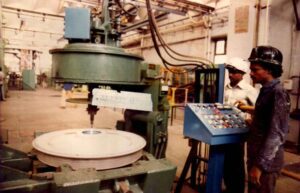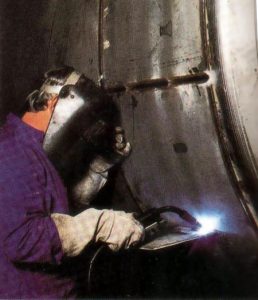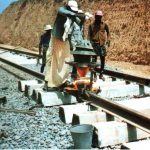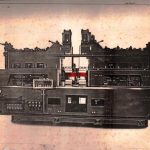Author: N.K. Sarkar, Retired Deputy Chief Metallurgist, Konkan Railway
Fig.1 shows the “Fairy Queen”, the steam loco hauled train
Indian Railways has always been the single most important agency in India’s infrastructure with the network of railway tracks expanding for many years. The Calcutta and Delhi Metros are the finest examples of highly complex engineering techniques being adopted to lay an underground railway in the densely built-up areas of Calcutta city and over the ground in the capital city of New Delhi. Special trains viz. Rajdhani, Shatabdi, Duranto, etc have been a commendation on the part of Indian Railways so far.
Introduction of welding technology has also been in pace with economic growth of the country. It is true that, with this support, Indian Railways have emerged as the major strength of Indian Economy. It was reported by the railways that the investments in rolling stocks especially in wagons, would be witnessing manifold increase as compared to the investments, made in earlier years. As a result, use of welding consumables and equipment will also enhance its production.Different types of materials shall be used for different types of coaches and wagons where a major change in the type and design of the wagons is also on the cards.

N.K. Sarkar, Retired Deputy Chief Metallurgist, Konkan Railway
Shielded Metal- Arc Welding
Earlier, most of the fabrication in rolling stocks such as coaches, wagons and locomotives used to be of riveted design.
Welding, prior to the fifties, was only used as a method of repairs on Indian Railways. Due to various constraints – both economical and technologinual and technological; manual metal arc welding was the predominant method of welding on Indian Railways. You will be surprised to note that the same rutile type of electrodes was used for different varieties of steels.
Traditionally, the repair workshops and sheds of railways was depended upon the use of shielded metal arc welding (SMAW) process and oxy-acetylene gas welding and no standard / code was available for the consumables or for the process / procedures.

Fig. 2: The Palace on Wheels train is one of the luxury trains in India
In the fifties; however, there have been numerous changes due to the increasing popularity of Welding Industries in India and abroad. Beside training and testing of welders, publication of various welding standards have achieved a greater measure of success in standardizing the quality of consumables, machines, welded products, the application of welding in the industry, inspection and testing of welded components.
Consequently, improvements in welding technologyhas aimed at higher productivity and lowering the fabrication cost and also with the setting up of Chittaranjan Locomotive Works (CLW), welding was accepted as a tool for fabrication on the railways for the manufacture of welded boilers for steam locomotives followed by Integral Coach Factory (ICF) for manufacturing of coaches and Diesel Locomotive Workshop (DLW) for the manufacturing of diesel locomotives. During the introduction of welding of the boilers for the steam locomotives, Industrial Radiography was introduced in 1956 at Chittaranjan for the first time. Indian Railways used this Radiography technology to maintain the quality of the welded joints, which were most important for the safety and economy. After the steam locomotives phased out, CLW switched over to diesel- electric / electric locomotives, which were also of welded design. Gradually, the railways set up two more production units viz. Diesel Loco Modernisation Workshop at Patiala and Railway Coach Factory at Kapurthala where welding is carried out on a large scare in the manufacturing of diesel loco components and coaches respectively.
Though Steam locomotives have been phased out from the main lines, steam locomotives are still used over the Nilgiri Mountain Railway and Darjeeling Himalayan Railway. Some of the Nilgiri locomotives were heavily rebuilt and converted to oil firing. New locomotives for the Darjeeling Himalayan Railway are being manufactured at the Golden Rock workshops of Southern Railway.
The Shielded Metal Arc Welding (SMAW) process continues to be the predominant method for repair and maintenance of railway components. This process is also used extensively in the fabrication of permanent installations like platform structures, overhead traction structures, foot-over bridges and similar applications where static and / or dynamic loading is involved.
Subsequently, welding was also extensively used for the fabrication of several components of higher capacity BOX, BCX, BOI, BOY type wagons.
Though SMAW was mostly used initially for the fabrication of rolling stocks its usage has been considerably reduced and only about 50 per cent welding fabrication is undertaken with this process to take care of areas which are inaccessible to automatic or semi-automatic processes.

Fig.3: SMAW welding is carried out on the Base frame of a diesel locomotive
SMAW is also used for reclamation / repair of motion components viz. equaliser beams, base frames (Fig.3), coupling rods, cam shafts, tri-mount bogies, bolsters, knuckles of centre buffer couplers, gas inlet casings, valve-seats etc. of locomotives.
Another area where SMAW is widely used is in the reclamation / resurfacing of components like Medium Manganese points and crossings. Water cooling during welding is used for hard facing of Austenitic Manganese Steel crossings (Fig.4) to avoid precipitation of unwanted phases and preserve good ductility and work hardening properties.

Fig.4: Hard facing of Austenitic Manganese Steel Crossing by SMAW
It is hardly surprising therefore that the Indian Railways too had gone for their own standards on SMA welding relating to materials, consumables, processes, applications, inspection and testing etc. The Indian Railways formulated their own specification no. IRS M-28, which covers classification, testing and approval of electrodes. The electrodes used by the railways are periodically assessed and classified by RDSO as per this specification.
Gas Cutting, Brazing and Plasma Cutting
About 70 percent Bharat Metal Cutting Gas manufactured by BPCL which is a mixture of propane and methane is used for cutting in place of Dissolved Acetylene on the railways. Each cylinder contains about 19cu.m gas. Due to its adequate quality, inexpensiveness, less toxicity, this gas has always been preferred the most.

Fig.5: Plasma cutting of stainless steel tough floor
Various processes have been used for welding of non-ferrous components on the railways. Brazing is one of the major processes used for joining Aluminum and Copper tubes for the heat exchangers in diesel locomotives. Silver brazing is worked out for the electronic relays and Armatures and also many other non-ferrous metal components.
Plasma cutting is widely used on the railways for cutting stainless steel sheets, tough floor and heavy steel sections etc. (Fig.5). This method is also used for making holes in the cast wheels (Fig.6).

Fig.6: Making holes in the solid cast wheels by plasma arc.
Sub-Merged Arc Welding
Along with the SMAW, sub-merged arc welding is also used for the fabrication of rolling stocks. This process is mainly used for fabrication of longer members. Automatic welding is used where the joints are long and uninterrupted and semi-automatic welding for the other locations.

Fig.7: showing the locations for welding of the engine block
The Engine Block (Fig.7), the principal structural member of the diesel engine is a composite weldment with heavy steel forgings, which serves as the crank shaft housing and hence becomes the backbone of the structure. This block employed both SMAW and Sub-merged Arc Welding processes. The inside and outside walls, middle and top decks side plates, fuel shelf compartments, cane bearing supports and end plates were welded in sequence by both SMAW as well as SAW process.
The SAW process is enormously used for fabrication of under frames, bogie structures, Central Pivots, side panels, bolster bogies, etc. of the rolling stocks. . The SAW process is used extensively at the resurrection of old diesel locomotives, which have served for 16 years or more was undertaken at the DMW, Patiala.
During service, wheel flanges of the carriage and wagon stocks wear out more than the tread portion resulting in the formation of thin and sharp flanges rendering the wheels unfit for service. Initially, SMAW was used for building up of worn out flanges, but this process was not very productive and also required the services of highly skilled and conscientious personnel. Besides, cracks were observed on the weld metal and the Heat Affected Zone due to faster cooling rate associated with high carbon equivalent (approx.0.60). It was therefore decided to switch over to the sub-merged arc welding method. Since mostly single-head machines were available, these were only used. Faster welding speeds with the use of high welding currents, problems of inter-pass cleaning were minimised due to the complete absence of spatter; the arc being confined within the blanket of flux, discomforts of SMAW were eliminated. The arc and deposited metal were protected from contamination with atmospheric oxygen and nitrogen by the blanket of flux at all times.

Fig.8: showing the 3-head sub-merged Arc welding machine for resurfacing of worn out wheel flanges.
The quality,in terms of being economical and its service of the built-up wheel flanges were found to be satisfactory. This prompted the railways to import 3-head sub-merged automatic welding machine (Fig.8) for improved productivity and quality of weld deposit. The welding technique with this machine had to be standardised with the positioning of welding heads in such a way that the individual beads just overlapped each other half-way. It had to be ensured that neither the weld metal was over-flown from the top of the flanges nor the tip was red hot. Besides the improvement in the economics in the reconditioning costs of worn-out flanges, the life of each reconditioned wheel would be increased at least by three times. Based on the experiences gained with this imported 3-head sub-merged arc welding, indigenous multiple-head sub-merged arc welding machines have been developed for use on the Indian Railways.

Fig. 9: Showing the plate girders being assembled for Sub-merged Arc welding
The post independence construction activity on the Indian Railways saw bridging of mighty rivers viz. Ganges, Brahmaputra, Godavari, Krishna, Mahanadi etc. Most of the bridges on the railways were steel girder bridges. Though the girders of these bridges were of riveted design, the flooring systems of these bridges were provided with welded design. SMAW process was used for welding of the flooring systems. Longuliabridge of 4 spans of about 46 m. length near Waltair (Visakhapatnam) was an example of where the girder truss members were of welded design. From the techno-economic studies, it was observed that the welded plate girders were about 25 per cent lighter and required less maintenance than those of the equivalent riveted girders. Therefore, SAW process was used for the fabrication of the longer members of the bridge girders. Fig.9 shows the assembly of the plate girder for one Railway Bridge. The bridges over Zuari (Fig.10) and Brahmaputra rivers having the longest span over 125 m were welded by sub-merged arc welding using indigenous steel and wire-flux combinations.

Fig. 10: shows the welded Railway Bridge over the river Zuari in Goa
The 290 km extension of the Indian Railway network will allow a 900 km journey direct from Delhi to Srinagar. Constructing the railway route to this isolated region has involved significant engineering challenges .The route includes many bridges, viaducts and tunnels – the lower section of the railway crosses a total of 158 bridges and passes through 20 tunnels, the longest of which is 11km in length. The greatest single engineering challenge was crossing the river Chenab which involves fabrication of a 1,315 m long bridge by welding, 359m above the river bed. This bridge will be the highest railway structure of its kind in the world, 35m higher than the tip of the Eiffel Tower in Paris.
As far as welding of bridges is concerned, a code of practice for metal arc welding in mild steel bridges carrying rail, rail-cum road or pedestrian traffic has been prepared (welded bridge code) by the railways. Similarly, IS Specification No. 1024 on code of practice for use of welding in bridges and structures subjected to dynamic loading was formulated by the Bureau of Indian Standards.
The railways also have gone for their own specification for the indigenous wire-flux combinations viz. IRS M-39 for all sub-merged arc welding on the railways.
GTAW and GMAW Processes
Both electric and diesel locomotives are equipped with electrical transmission system with DC series Traction Motors which has commutators on which the armature coils were originally connected with conventional soldering method. These joints were weak and failed in service frequently due to increased resistance between the two adjoining commutator segments. These joints were later made by Automatic TIG welding using a special technique of welding on the first circular row first and then automatically transferred on to the second row and so on till the welding was completed. There was a time gap of about 1.5 seconds between the two consecutive spots. The reclaimed commutators were satisfactory in service. TIG welding is used for the joining of Central Pivots to the bogies.

Fig.11: shows TIG welding being carried out on Aluminium Water tanks
TIG welding is also used for repairing of overhead aluminum and stainless steel water tanks in coaches (Fig.11). The aluminum Pistons, made of forged aluminum alloy used to get damaged in service. These used to be replaced earlier by new pistons. Later, with the introduction of TIG welding on the railways, these damaged pistons were reclaimed by TIG welding using 1.6 mm aluminum alloy wires.
RDSO have taken an Indian Patent for the development of filler wires for TIG welding of leaded bronzes in seventies and quite incidentally I have been partnered in the Patent.
Along with SMAW and SAW, GMAW process is used for the fabrication of long components like bridge girders, under frames and bogies of rolling stocks and also superstructures of carriage and wagons. Rail Coach Factory at Kapurthala uses MIG / MAG welding with solid and flux cored wires while Integral Coach Factory at Chennai uses mostly flux cored wires.

Fig. 12: MIG welding being carried out on the side panels of a coach
MIG welding is used for rehabilitation of coaches (Fig.12). Almost 50 to 70 per cent components in coaching stocks including chassis, under frame (for maintenance), head stock etc are subjected to MIG welding. Gas mixture of carbon dioxide, argon and oxygen are used for Mid Life Rehabilitation of coaches after its 12.5 years’ service. Flux- cored wires are used with this gas mixture (Fig.13).

Fig.13: showing the FCAW in progress
Except for a few special-purpose wagons,most of the wagons are made of steel andsome specialized wagons have been introduced with stainless steel or special alloy steels to reduce the corrosion. Some BOBR-AL wagons have been made of aluminum in these, the under frame is made of steel while the rest of the body is made of aluminum. The aluminum alloy used is ‘RDE-40’, and has 4 per cent zinc, 2 per cent magnesium, 0.35 per cent manganese, and 0.15 per cent zirconium. The under frame and the body of these type of wagons are joined by the use of Huck Bolting system. These aluminum wagons have the advantage of less corrosion in many circumstances. A typical rake with aluminum wagons instead of steel ones would carry almost 240t more goods.
Robotic Welding

Fig.14: Robotic welding of a coach at ICF
Robotic welding has been intiated for manufacturing coaches both at ICF, Chennai (Fig.14) and also by the private companies. This process is also used for manufacturing wagons and bridge girders in a limited way. Some private companies adopt robotic welding for fabrication of pre-welded long and high height structural beams which are used by the railways for their bridges and structures. Since this is automatic, there will be drastic changes in productivity as the quality of welds will certainly be inimproved conditions.
Friction Welding
The Friction welding is the only method for joining two portions of bi-metallic diesel engine valves. The quality of the joints is satisfactory and hardly any weld failure has been reported. Moreover, this technique is widely used by the private companies for the railways.
Electrical Resistance Welding
ERW process is used for welding of the chain links used for the break down trains and also for joining alloy steel tool bits with the mild steel shanks. Pipes and tubes used on the carriage and wagons are also welded by this same method.
Stainless Steel Coaches And Wagons
We all have seen the present day coaches painted in different colours. Painting is one area where climatic conditions and continued exposures to sun and elements have not allowed even the best paints to have long durability which further causes frequent withdrawal of coaches for repainting etc.
The use of stainless steel coaches made of 409 M grade (Cr -10.8 to12.5 %; Ni – 1.5 %max.; C – 0.03% max.) have reduced corrosion considerably but these coaches require painting. In order to do away the high cost of repeated painting, the railways have decided to go for 301LN grade (Cr – 16.0 to 18.0 %; Ni – 6.0 to 8.0 %; C – 0.030% N -0.1%) austenitic stainless steel in order to eliminate the need of painting. New generation EMU coaches are made of 304 grade (Cr-18.0 to 20.0%; Ni- 8.0 to 10.5 %; C- 0.08%) stainless steels. Stainless Steel is also used for inside furnishing of the coaches. FCAW is used at ICF while RCF uses solid wires. Delhi Metro coaches do not require painting as they are made of 301L & 304 stainless steels.
Similarly, the stainless steel wagons with a high pay load are designed to overcome the corrosion, body bulging and weak stanchions. 409M grade Stainless Steel is used for the construction of wagons. GMAW are used with solid wires as well as flux cored wires and gas mixtures for their fabrication. Stainless steel components are welded at some locations with dissimilar metals. These welded joints are subjected to some special treatments so that these areas do not require any restorations than the rest of the coaches.
TRACK WELDING:
All of us are familiar with the clickety – click sound of rail joints. This sound is unpleasant to the passengers. It is primarily objectionable because of the additional maintenance expenses. This unpleasant sound comes from the fish-plated joints and if these joints could be eliminated, the track will give better riding comforts, reduce maintenance costs and safe- guard from sabotage. It is hardly surprising therefore that the railways have gone for laying welded rails.
There are three main processes for welding of rail joints: Alumino-Thermic, Flash-Butt and Gas Pressure welding.
Alumino-Thermic Welding

Fig.15: Thermit welding of rail joint is in progress
Alumino-Thermic commonly known as thermit welding is the pioneer in-situ rail welding process throughout the world. The process is simple and no expensive equipment is required. It is similar to steel making process (Fig.15). The weld metal is produced by the exothermic reaction between aluminum and iron oxide, carried out in a refractory lined crucible. Keeping in view the rail steel chemistry and the metallurgical aspects of the weld deposit, the mixture is formulated. Besides, aluminum and iron oxide, steel chips, Ferro-manganese, Ferro-silicon, calcium fluoride, vanadium etc. are added in the mixture in proportions appropriate to that required in the final weld metal. Petrol and air mixture is used for preheating the rail ends covered with refractory moulds.
Flash-Butt Welding

Fig. 16: Flash-Butt welding machine for rail welding
Gas Pressure Welding is also another method of joining of rail ends. This process is largely used in many of the advanced countries for their high speed routes. So far, only two railways in India have used this process. It is a solid phase bonding process where the heating temperature never exceeds beyond the solidus of the metals i.e. the temperature does not reach the fusion point of the metals.
In this method, the rail ends are butted against each other without any gap (Fig.17) in between at a very high pressure, which is then heated by a special designed burner in the shape of the rail ends to about 1,200°C. When the desired upset is reached, heating is discontinued. The upset metal is trimmed off all round the contour of the rail section. The quality of the joints is the best amongst all the methods of joining of rail ends.
Quality of Rail Joints
In its effort to minimise train accidents vis-à-vis quality of the rail joints, the railways have pressed into service a slew of sophisticated devices including the state-of-the-art SPURT (Self-Propelled Ultrasonic Rail Testing) car to detect defects in the rail and welded joints. With an on board computer, this car can detect the flaws more objectively and accurately while running at 40kmph. The other sophisticated testing equipments include full size fatigue testing equipment are used to maintain the quality of rail joints.
Conclusion
Except for some exotic and costly welding processes developed especially for jobbing types of application in defence, nuclear and aviation industry, Indian Railways use almost all welding processes available today. As a result, welding has progressed leaps and bounds on Indian Railways and today they are the largest users of welding consumables and equipment.
The railways to arrange for sufficient numbers of qualified professionals besides, training and certification of their supervisors and skilled artisans.
The success of the Metro-lines has prompted other State Governments to go for metro-rail system in their big cities especially Mumbai, Bangalore and Hyderabad and Chennai.
As India moves towards a relative prosperity, it will force Indian Railways to opt for more advanced welding technology for creating Railway assets in future.






